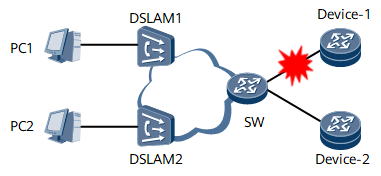IPv6 Unicast Forwarding Control
This section describes the different roles of NetEngine 8000 Fs as broadband remote access servers (BRASs), Dynamic Host Configuration Protocol version 6 (DHCPv6) servers, and DHCPv6 relay agents respectively in Internet Protocol version 6 (IPv6) unicast forwarding control.
NetEngine 8000 Fs Functioning as BRASs
On the network shown in Figure 1, NetEngine 8000 F-1 and NetEngine 8000 F-2 function as BRASs and run redundancy user information (RUI). A Virtual Router Redundancy Protocol (VRRP) group is configured for the two NetEngine 8000 Fs, with NetEngine 8000 F-1 as the master and NetEngine 8000 F-2 as the backup. When the link between the switch (SW) and NetEngine 8000 F-1 goes faulty, the fault triggers a master/backup VRRP switchover. Then, NetEngine 8000 F-2 becomes the master and starts neighbor discovery (ND) detection, and NetEngine 8000 F-1 becomes the backup and stops the ND detection. If the link-local address or MAC address on an interface of NetEngine 8000 F-2 is different from that of an interface on NetEngine 8000 F-1, some users will go offline, or some user packets will be discarded.
To prevent a user from detecting the active link fault, NetEngine 8000 F-2 must use the same link-local address and MAC address as those of NetEngine 8000 F-1.
Link-local address generation
When an NetEngine 8000 F sends ND packets, its source IP address must be filled with a link-local address.
After RUI is enabled on the NetEngine 8000 Fs, the master and backup BRASs generate the same link-local address using the virtual MAC address of the VRRP group. The link-local address is generated automatically, which is convenient for users.
Protection tunnel forwarding
An address pool backup allows the master and backup BRASs to have the same MAC address. Address pool backup in IPv6 unicast forwarding control is similar to that in IPv4 unicast forwarding control. For details, see chapter IPv4 Unicast Forwarding Control
IPv6 unicast forwarding allows the NetEngine 8000 Fs to control traffic through multiprotocol label switching (MPLS) label switched paths (LSPs) and supports simplified protection tunnel configuration, requiring only MPLS LSPs for virtual private networks (VPNs). Each VPN swaps its forwarding labels using a Huawei-proprietary protocol, avoiding the need to configure the Border Gateway Protocol (BGP) on the NetEngine 8000 Fs.
NetEngine 8000 Fs Functioning as DHCPv6 Relay Agents
On the network shown in Figure 2, the NetEngine 8000 Fs act as the master and backup DHCPv6 relay agents. A unique DHCPv6 relay agent remote-ID identifies the master DHCPv6 relay agent. In the RUI-enabled scenario, to enable the backup DHCPv6 relay agent to forward the DHCPv6 packets after a master/backup switchover, the master and backup DHCPv6 relay agents must use the same DHCPv6 relay agent remote-ID. This way ensures that the DHCPv6 server processes the packets correctly.
The RUI-enabled PC uses the DUID that identifies the master and backup DHCPv6 servers as the DHCPv6 relay agent remote-ID to identify both the master and backup DHCPv6 relay agents.

